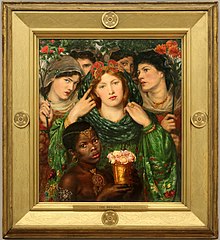Fanny Eaton
Fanny Eaton (born June 23, 1835 in Saint Andrew Parish Jamaica , † March 4, 1924 in Hammersmith England ) was a Jamaican-British artist model of Simeon Solomon , Dante Gabriel Rossetti , John Everett Millais , Joanna Mary Boyce , Rebecca Solomon and other Pre-Raphaelites .
life and work
Eaton was born Fanny Antwistle or Entwhistle to Mathilda Foster, a former slave of African descent who had worked on British-owned plantations. Eaton likely had a white European father, possibly the British soldier James Entwistle (or Antwistle). No essential information about Eaton's father has yet been found. The Atlantic slave trade had been abolished in 1807, but it was not until 1834 that slavery was completely abolished in the British colonies. Despite new laws, many enslaved individuals remained tied to their former masters as "apprentices" for another six years, until further laws abolishing the apprenticeship clause were passed in 1838 and all former slaves became legal British citizens. All children were born free citizens in a British colony.
Eaton came to England with her mother in the 1840s and worked as a domestic servant in London in 1851. When she came of age, she lived with horse-drawn carriage driver James Eaton in London's Coram Fields and they had ten children between 1858 and 1879. Her great-grandson Brian Eaton suspects that they were not married because no certificate has ever been found. The painter Simeon Solomon lived with his family near their home, where they worked as a cleaning lady, so he may have discovered her as a model. From 1868 to 1878 she was regularly employed as an artist model at the Royal Academy of Arts . Records show that in July 1860 she was paid 15 shillings for three sessions. She appeared with her face on numerous Pre-Raphaelite drawings and paintings from around 1859 to 1867. She was in demand for a variety of subjects, and the children who appear next to her on paintings were probably her own. In 1860, her face was shown in the Royal Academy's Academy Exhibition in the painting by nineteen-year-old Simeon Solomon "The Mother of Moses". The subject of the picture was taken from the book of Exodus and shows a scene of family ties just before Moses is placed in a basket and is supposed to swim up the Nile. The fact that Eaton just gave birth to their son James and had a two-year-old daughter can see this painting as a visual representation of Eaton's own family. Her looks also made her a model in images of Rossetti, John Everett Millais, Joanna Boyce Wells, Rebecca Solomon, and others. Drawings by Frederick Sandys are also identified as studies by Eaton, as is an oil study by the Australian artist Robert Hawker Dowling , who was active in London around 1860.
The Pre-Raphaelites represented her as various exotic characters, as Hebrew, Oriental, and Indian, but no one painted her as a Jamaican. During the period in which she modeled for the Pre-Raphaelites, she gave birth to five children. In 1868 she stopped modeling and had more children in 1871, 1872, 1876 and 1879. After James Eaton died in 1881, she had to raise and care for her surviving children on her own. She had lived as a seamstress in Kensington since 1971 and was a housekeeper in Hammersmith in 1891. In 1901 she was a home cook for a wine merchant on the Isle of Wight and in 1911 she lived in Hammersmith with her daughter Julia, Julia's husband and two children. She most likely died in the house of one of her children in 1924. Her final resting place was the Margravial Cemetery in Hammersmith. In 2018, The Voice newspaper listed her as the black women who contributed to the development of Britain, alongside Kathleen Wrasama , Olive Morris , Connie Mark , Diane Abbott , Lilian Bader , Margaret Busby and Mary Seacole to mark the 100th anniversary of women's suffrage . From October 2019 to January 2020, Eaton was one of 12 women represented in the Pre-Raphaelite Sisters exhibition at the National Portrait Gallery (London) .
literature
- Roberto C. Ferrari: "Fanny Eaton: The 'Other' Pre-Raphaelite Model", PRS Review, 2014.
- Gretchen Holbrook Gerzina: Black Victorians / Black Victoriana, 2003.
- Jan Marsh: Black Victorians: Black People in British Art 1800–1900, Manchester Art Gallery, 2005.
- Jan Marsh: 'Pictured at Work: Employment in Art (1800–1900)', Historical Studies in Ethnicity, Migration and Diaspora, Vol. 28, 2010.
- Pamela Gerrish Nunn, 'Artist and Model: Joanna Mary Boyce's Mulatto Woman', Journal of Pre-Raphaelite Studies 2, 1993.
- Judy Raymond: "Fanny Eaton: forgotten beauty '" in Caribbean Beat, Issue 143, January / February 2017.
- Shola von Reynolds: 'Fanny Eaton: The Black Pre-Raphaelite Muse that Time Forgot', AnOther Magazine, March 2016.
- Robinson, Jane, Mary Seacole: The Most Famous Black Woman of the Victorian Age, New York: Carroll & Graf Publishers, 2004.
- Surtees, Virginia: The Paintings and Drawings oj Dante Gabriel Rossetti (1828–1882): A Catalog Raisonni, vol. 1, Oxford: Clarendon Press, 1971.
Web links
- Question 100: The Black Women Who Changed British History
- Fanny Eaton: Jamaican Pre-Raphaelite muse
- Fanny Eaton: forgotten beauty
- This pre-Raphaelite muse was Britain's most visible Victorian woman of color
- Lecture: Brian Eaton: 'Discovering Fanny Eaton: Daughter of a Slave & Inspiration for Pre-Raph Art'
- Fanny Eaton, the Jamaican-born model in Millais' Jephthah
| personal data | |
|---|---|
| SURNAME | Eaton, Fanny |
| ALTERNATIVE NAMES | Antwistle, Fanny |
| BRIEF DESCRIPTION | Jamaican-British artist model |
| DATE OF BIRTH | June 23, 1835 |
| PLACE OF BIRTH | Saint Andrew Parish Jamaica |
| DATE OF DEATH | March 4, 1924 |
| Place of death | Hammersmith England |


